Effects of Climatic Disturbance on the Trade-Off between the Vegetation Pattern and Water Balance Based on a Novel Model and Accurately Remotely Sensed Data in a Semiarid Basin
Abstract
1. Introduction
2. Materials and Methods
2.1. Study Area
2.2. Data Collection
2.2.1. Field Sampling Data
2.2.2. In Situ Observation Data
2.2.3. Related Remotely Sensed Data
Vegetation Data
Soil Moisture Data
Precipitation Data
2.3. Soil Moisture Validation
2.4. Coupled Ecohydrological Model
2.4.1. Eagleson’s Ecohydrological Model
2.4.2. Budyko Framework
3. Results
3.1. Runoff Simulation Accuracy
3.2. Spatial Pattern of Multiyear M, M*, and ΔM
3.3. Sensitivity of M* to Vegetation Parameters
3.4. Sensitivity of M* to Meteorological Parameters
3.5. Analysis of Vegetation Coverage Threshold under Different Climate Conditions
4. Discussion
4.1. Improvements of the Model
4.2. Analysis of Vegetation Coverage
4.3. Application of the Derived Conclusions
5. Conclusions
- By modifying the flow term in the water balance equation, the accuracy of the runoff estimation was improved. By validating the soil moisture remote sensing data using multiply data, the application of the model has been promoted.
- The optimal vegetation coverage under the long-term ecohydrological balance for the period of 1982–2012 was calculated. The average vegetation coverage for the entire watershed was 0.62, whereas the average optimal vegetation coverage was 0.56. Regions where the optimal vegetation coverage was lower than the actual vegetation coverage were mainly distributed in the eastern mountainous forest areas of the watershed, namely subwatersheds A, B, E, and F, whereas regions where the optimal vegetation coverage was higher than the actual vegetation coverage were mainly distributed in the southwestern grassland areas of subwatersheds C and D.
- The sensitivity of the optimal vegetation coverage to the vegetation parameters, including , , and , was analyzed. It was evident that the optimal vegetation coverage had the least sensitivity to and the greatest sensitivity to increases in and decreases in , resulting in a higher optimal vegetation coverage.
- The sensitivity of the optimal vegetation coverage to meteorological parameters, including , , , and T, was also analyzed. It was found that the optimal vegetation coverage was most sensitive to , and that it increased with increases in and decreased with reductions in , , and T.
- On the basis of the analysis of climate change using the dynamic threshold of vegetation, it was found that the watershed only achieved an equilibrium state under sustainable development conditions when the rainfall increased by 10%, 20%, and 30% without an increase in T, or when the rainfall increased by 20% with an increase in T of 1 °C.
Author Contributions
Funding
Data Availability Statement
Conflicts of Interest
References
- Wen, Z.; Wu, S.; Chen, J.; Lü, M. NDVI indicated long-term interannual changes in vegetation activities and their responses to climatic and anthropogenic factors in the Three Gorges Reservoir Region, China. Sci. Total Environ. 2017, 574, 947–959. [Google Scholar] [CrossRef]
- Ge, W.; Deng, L.; Wang, F.; Han, J. Quantifying the contributions of human activities and climate change to vegetation net primary productivity dynamics in China from 2001 to 2016. Sci. Total Environ. 2021, 773, 145648. [Google Scholar] [CrossRef]
- Wang, Q.; Ju, Q.; Wang, Y.; Shao, Q.; Zhang, R.; Liu, Y.; Hao, Z. Vegetation Changing Patterns and Its Sensitivity to Climate Variability across Seven Major Watersheds in China. Int. J. Environ. Res. Public. Health 2022, 19, 13916. [Google Scholar] [CrossRef]
- Zhang, P.; Cai, Y.; He, Y.; Xie, Y.; Zhang, X.; Li, Z. Changes of vegetational cover and the induced impacts on hydrological processes under climate change for a high-diversity watershed of south China. J. Environ. Manag. 2022, 322, 115963. [Google Scholar] [CrossRef]
- Ma, N.; Szilagyi, J.; Zhang, Y. Calibration-Free Complementary Relationship Estimates Terrestrial Evapotranspiration Globally. Water Resour. Res. 2021, 57, e2021WR029691. [Google Scholar] [CrossRef]
- Yang, Y.; Donohue, R.J.; McVicar, T.R.; Roderick, M.L. An analytical model for relating global terrestrial carbon assimilation with climate and surface conditions using a rate limitation framework. Geophys. Res. Lett. 2015, 42, 9825–9835. [Google Scholar] [CrossRef]
- Hidalgo, A.; Tello, L. Modeling and Numerical Simulation of a Vegetation Cover. Math. Comput. Sci. 2021, preprint. [Google Scholar] [CrossRef]
- Xin, Z.; Xu, J.; Zheng, W. Spatiotemporal variations of vegetation cover on the Chinese Loess Plateau (1981–2006): Impacts of climate changes and human activities. Sci. China Ser. Earth Sci. 2008, 51, 67–78. [Google Scholar] [CrossRef]
- Deng, Y.; Wang, S.; Bai, X.; Luo, G.; Wu, L.; Chen, F.; Wang, J.; Li, C.; Yang, Y.; Hu, Z.; et al. Vegetation greening intensified soil drying in some semi-arid and arid areas of the world. Agric. For. Meteorol. 2020, 292–293, 108103. [Google Scholar] [CrossRef]
- Zhu, Z.; Piao, S.; Myneni, R.B.; Huang, M.; Zeng, Z.; Canadell, J.G.; Ciais, P.; Sitch, S.; Friedlingstein, P.; Arneth, A.; et al. Greening of the Earth and its drivers. Nat. Clim. Chang. 2016, 6, 791–795. [Google Scholar] [CrossRef]
- Chen, C.; Park, T.; Wang, X.; Piao, S.; Xu, B.; Chaturvedi, R.; Fuchs, R.; Brovkin, V.; Ciais, P.; Fensholt, R.; et al. China and India lead in greening of the world through land-use management. Nat. Sustain. 2019, 2, 122–129. [Google Scholar] [CrossRef]
- Peña-Arancibia, J.L.; Bruijnzeel, L.A.; Mulligan, M.; van Dijk, A.I.J.M. Forests as ‘sponges’ and ‘pumps’: Assessing the impact of deforestation on dry-season flows across the tropics. J. Hydrol. 2019, 574, 946–963. [Google Scholar] [CrossRef]
- Te Wierik, S.A.; Cammeraat, E.L.H.; Gupta, J.; Artzy-Randrup, Y.A. Reviewing the Impact of Land Use and Land-Use Change on Moisture Recycling and Precipitation Patterns. Water Resour. Res. 2021, 57, e2020WR029234. [Google Scholar] [CrossRef]
- Spracklen, D.; Arnold, S.; Taylor, C. Observations of increased tropical rainfall preceded by air passage over forests. Nature 2012, 489, 282–285. [Google Scholar] [CrossRef]
- Bentley, L.; Coomes, D.A. Partial river flow recovery with forest age is rare in the decades following establishment. Glob. Chang. Biol. 2020, 26, 1458–1473. [Google Scholar] [CrossRef]
- Cui, J.; Lian, X.; Huntingford, C.; Gimeno, L.; Wang, T.; Ding, J.; He, M.; Xu, H.; Chen, A.; Gentine, P.; et al. Global water availability boosted by vegetation-driven changes in atmospheric moisture transport. Nat. Geosci. 2022, 15, 982–988. [Google Scholar] [CrossRef]
- Zeng, Z.; Piao, S.; Li, L.Z.X.; Wang, T.; Ciais, P.; Lian, X.; Yang, Y.; Mao, J.; Shi, X.; Myneni, R.B. Impact of Earth Greening on the Terrestrial Water Cycle. J. Clim. 2018, 31, 2633–2650. [Google Scholar] [CrossRef]
- Li, X.; Wang, Y.; Xue, B.; A, Y.; Zhang, X.; Wang, G. Attribution of runoff and hydrological drought changes in an ecologically vulnerable basin in semi-arid regions of China. Hydrol. Process. 2023, 37, e15003. [Google Scholar] [CrossRef]
- Xue, B.; A, Y.; Wang, G.; Helman, D.; Sun, G.; Tao, S.; Liu, T.; Yan, D.; Zhao, T.; Zhang, H.; et al. Divergent Hydrological Responses to Forest Expansion in Dry and Wet Basins of China: Implications for Future Afforestation Planning. Water Resour. Res. 2022, 58, e2021WR031856. [Google Scholar] [CrossRef]
- Wu, Y.; Zhang, H.; Lan, T.; Wei, X.; Shao, S.; Zhang, J.; Ding, H. Attribution of runoff variation to climate and human-driven changes in the transition zone between the Qinling Mountains and the Loess Plateau under vegetation greening. Hydrol. Res. 2022, 53, 733–753. [Google Scholar] [CrossRef]
- Bai, P.; Liu, X.; Zhang, Y.; Liu, C. Assessing the Impacts of Vegetation Greenness Change on Evapotranspiration and Water Yield in China. Water Resour. Res. 2020, 56, e2019WR027019. [Google Scholar] [CrossRef]
- Zhou, G.; Wei, X.; Chen, X.; Zhou, P.; Liu, X.; Xiao, Y.; Sun, G.; Scott, D.; Zhou, S.-Y.-D.; Han, L.; et al. Global pattern for the effect of climate and land cover on water yield. Nat. Commun. 2015, 6, 5918. [Google Scholar] [CrossRef] [PubMed]
- Fang, Q.; Wang, G.; Zhang, S.; Peng, Y.; Xue, B.; Cao, Y.; Shrestha, S. A novel ecohydrological model by capturing variations in climate change and vegetation coverage in a semi-arid region of China. Environ. Res. 2022, 211, 113085. [Google Scholar] [CrossRef]
- Shao, W.; Yang, D.; Sun, F.; Wang, J. Analyzing the Regional Soil-Vegetation-Atmosphere Interaction Using Both the Eagleson and Budyko’s Water Balance Models. Procedia Environ. Sci. 2011, 10, 1908–1913. [Google Scholar] [CrossRef][Green Version]
- Zhang, S.; Yang, D.; Yang, Y.; Piao, S.; Yang, H.; Lei, H.; Fu, B. Excessive Afforestation and Soil Drying on China’s Loess Plateau. J. Geophys. Res. Biogeosci. 2018, 123, 923–935. [Google Scholar] [CrossRef]
- Liang, W.; Bai, D.; Wang, F.; Fu, B.; Yan, J.; Wang, S.; Yang, Y.; Long, D.; Feng, M. Quantifying the impacts of climate change and ecological restoration on streamflow changes based on a Budyko hydrological model in China’s Loess Plateau. Water Resour. Res. 2015, 51, 6500–6519. [Google Scholar] [CrossRef]
- Zhang, S.; Yang, H.; Yang, D.; Jayawardena, A.W. Quantifying the effect of vegetation change on the regional water balance within the Budyko framework. Geophys. Res. Lett. 2016, 43, 1140–1148. [Google Scholar] [CrossRef]
- Du, C.; Sun, F.; Yu, J.; Liu, X.; Chen, Y. New interpretation of the role of water balance in an extended Budyko hypothesis in arid regions. Hydrol. Earth Syst. Sci. 2016, 20, 393–409. [Google Scholar] [CrossRef]
- Wang, D.; Tang, Y. A one-parameter Budyko model for water balance captures emergent behavior in darwinian hydrologic models. Geophys. Res. Lett. 2014, 41, 4569–4577. [Google Scholar] [CrossRef]
- Li, H.; Liu, L.; Koppa, A.; Shan, B.; Liu, X.; Li, X.; Niu, Q.; Cheng, L.; Miralles, D. Vegetation greening concurs with increases in dry season water yield over the Upper Brahmaputra River basin. J. Hydrol. 2021, 603, 126981. [Google Scholar] [CrossRef]
- Mo, K.; Cong, Z.; Lei, H. Optimal vegetation cover in the Horqin Sands, China. Ecohydrology 2016, 9, 700–711. [Google Scholar] [CrossRef]
- Zhang, Y.; Zhao, T.; Shi, C.; Ma, Q. Simulation of Vegetation Cover Based on the Theory of Ecohydrological Optimality in the Yongding River Watershed, China. Forests 2021, 12, 1377. [Google Scholar] [CrossRef]
- Almalki, R.; Khaki, M.; Saco, P.M.; Rodriguez, J.F. Monitoring and Mapping Vegetation Cover Changes in Arid and Semi-Arid Areas Using Remote Sensing Technology: A Review. Remote Sens. 2022, 14, 5143. [Google Scholar] [CrossRef]
- Khan, Z.; Khan, Z.; Ahmed, A.; Bazai, M.H. Land use/land cover change detection and prediction using the CA-Markov model: A case study of Quetta city, Pakistan. J. Geogr. Soc. Sci. (JGSS) 2021, 2, 164–182. [Google Scholar]
- A, Y.; Wang, G.; Liu, T.; Xue, B.; Kuczera, G. Spatial variation of correlations between vertical soil water and evapotranspiration and their controlling factors in a semi-arid region. J. Hydrol. 2019, 574, 53–63. [Google Scholar] [CrossRef]
- Fang, Q.; Wang, G.; Liu, T.; Xue, B.-L.; A, Y. Controls of carbon flux in a semi-arid grassland ecosystem experiencing wetland loss: Vegetation patterns and environmental variables. Agric. For. Meteorol. 2018, 259, 196–210. [Google Scholar] [CrossRef]
- Li, J.; Bai, X.; Jin, Y.; Song, F.; Chen, Z.; Cai, L.; Zou, F.; Jiang, M.; Yun, R.; Lv, Z. Recent Intensified Runoff Variability in the Hailar River Basin during the Past Two Centuries. J. Hydrometeorol. 2020, 21, 2257–2273. [Google Scholar] [CrossRef]
- Fang, Q.; Xin, X.; Guan, T.; Wang, G.; Zhang, S.; Ma, M. Vegetation patterns governing the competitive relationship between runoff and evapotranspiration using a novel water balance model at a semi-arid watershed. Environ. Res. 2022, 214, 113976. [Google Scholar] [CrossRef] [PubMed]
- Han, D.; Wang, G.; Liu, T.; Xue, B.-L.; Kuczera, G.; Xu, X. Hydroclimatic response of evapotranspiration partitioning to prolonged droughts in semiarid grassland. J. Hydrol. 2018, 563, 766–777. [Google Scholar] [CrossRef]
- Su, T.; Zhang, B.; He, X.; Shao, R.; Li, Y.; Tian, J.; Long, B.; He, C. Rational Planning of Land Use Can Maintain Water Yield Without Damaging Ecological Stability in Upstream of Inland River: Case Study in the Hei River Basin of China. J. Geophys. Res. Atmos. 2020, 125, e2020JD032727. [Google Scholar] [CrossRef]
- Cong, Z.; Li, Q.; Mo, K.; Zhang, L.; Shen, H. Ecohydrological optimality in the Northeast China Transect. Hydrol. Earth Syst. Sci. 2017, 21, 2449–2462. [Google Scholar] [CrossRef]
- Duan, L.; Man, X.; Kurylyk, B.L.; Cai, T.; Li, Q. Distinguishing streamflow trends caused by changes in climate, forest cover, and permafrost in a large watershed in northeastern China. Hydrol. Process. 2017, 31, 1938–1951. [Google Scholar] [CrossRef]
- Niu, L.; Ye, B.; Ding, Y.; Li, J.; Zhang, Y.; Sheng, Y.; Yue, G. Response of hydrological processes to permafrost degradation from 1980 to 2009 in the Upper Yellow River Basin, China. Hydrol. Res. 2016, 47, 1014–1024. [Google Scholar] [CrossRef]
- Wang, T.; Yang, H.; Yang, D.; Qin, Y.; Wang, Y. Quantifying the streamflow response to frozen ground degradation in the source region of the Yellow River within the Budyko framework. J. Hydrol. 2018, 558, 301–313. [Google Scholar] [CrossRef]
- Fatichi, S.; Pappas, C.; Ivanov, V.Y. Modeling plant–water interactions: An ecohydrological overview from the cell to the global scale. WIREs Water 2016, 3, 327–368. [Google Scholar] [CrossRef]
- Barkaoui, K.; Navas, M.; Roumet, C.; Cruz, P.; Volaire, F. Does water shortage generate water stress? An ecohydrological approach across Mediterranean plant communities. Funct. Ecol. 2017, 31, 1325–1335. [Google Scholar] [CrossRef]
- Mu, S.; Yang, H.; Li, J.; Chen, Y.; Gang, C.; Zhou, W.; Ju, W. Spatio-temporal dynamics of vegetation coverage and its relationship with climate factors in Inner Mongolia, China. J. Geogr. Sci. 2013, 23, 231–246. [Google Scholar] [CrossRef]
- Sun, Y.; Guo, P.; Yan, X.; Zhao, T. Dynamics of vegetation cover and its relationship with climate change and human activities in Inner Mongolia. J. Nat. Resour. 2010, 25, 407–414. (In Chinese) [Google Scholar]
- Xu, X.; Li, X.; Liang, H.; Huang, L. Change in vegetation coverage and its relationships with climatic factors in temperate steppe, Inner Mongolia. Acta Ecol. Sin. 2010, 30, 3733–3743. (In Chinese) [Google Scholar]
- Lü, Y.; Fu, B.; Feng, X.; Zeng, Y.; Liu, Y.; Chang, R.; Sun, G.; Wu, B. A Policy-Driven Large Scale Ecological Restoration: Quantifying Ecosystem Services Changes in the Loess Plateau of China. PLoS ONE 2012, 7, e31782. [Google Scholar] [CrossRef]
- Wu, Z.; Wu, J.; Liu, J.; He, B.; Lei, T.; Wang, Q. Increasing terrestrial vegetation activity of ecological restoration program in the Beijing–Tianjin Sand Source Region of China. Ecol. Eng. 2013, 52, 37–50. [Google Scholar] [CrossRef]
- Xue, B.; Helman, D.; Wang, G.; Xu, C.-Y.; Xiao, J.; Liu, T.; Wang, L.; Li, X.; Duan, L.; Lei, H. The low hydrologic resilience of Asian Water Tower basins to adverse climatic changes. Adv. Water Resour. 2021, 155, 103996. [Google Scholar] [CrossRef]
- Chen, Y.; Wu, B.; Chen, D.; Qi, Y. Using Machine Learning to Assess Site Suitability for Afforestation with Particular Species. Forests 2019, 10, 739. [Google Scholar] [CrossRef]
- Liu, Y.; Miao, H.-T.; Huang, Z.; Cui, Z.; He, H.; Zheng, J.; Han, F.; Chang, X.; Wu, G.-L. Soil water depletion patterns of artificial forest species and ages on the Loess Plateau (China). For. Ecol. Manag. 2018, 417, 137–143. [Google Scholar] [CrossRef]
- Zhou, G.; Xia, J.; Zhou, P.; Shi, T.; Li, L. Not vegetation itself but mis-revegetation reduces water resources. Sci. China Earth Sci. 2021, 64, 404–411. [Google Scholar] [CrossRef]
- Feng, X.; Fu, B.; Piao, S.; Wang, S.; Ciais, P.; Zeng, Z.; Lü, Y.; Zeng, Y.; Li, Y.; Jiang, X.; et al. Revegetation in China’s Loess Plateau is approaching sustainable water resource limits. Nat. Clim. Chang. 2016, 6, 1019–1022. [Google Scholar] [CrossRef]
- Fang, Q.; Wang, G.; Xue, B.; Liu, T.; Kiem, A. How and to what extent does precipitation on multi-temporal scales and soil moisture at different depths determine carbon flux responses in a water-limited grassland ecosystem? Sci. Total Environ. 2018, 635, 1255–1266. [Google Scholar] [CrossRef]
- Cui, Q.Y.; Chen, Z.Z.; Du, Z.C. Characteristics of light energy and water utilization of major plants in semi-arid grasslands. Acta Prataculturae Sin. 2001, 10, 14–21. (In Chinese) [Google Scholar]

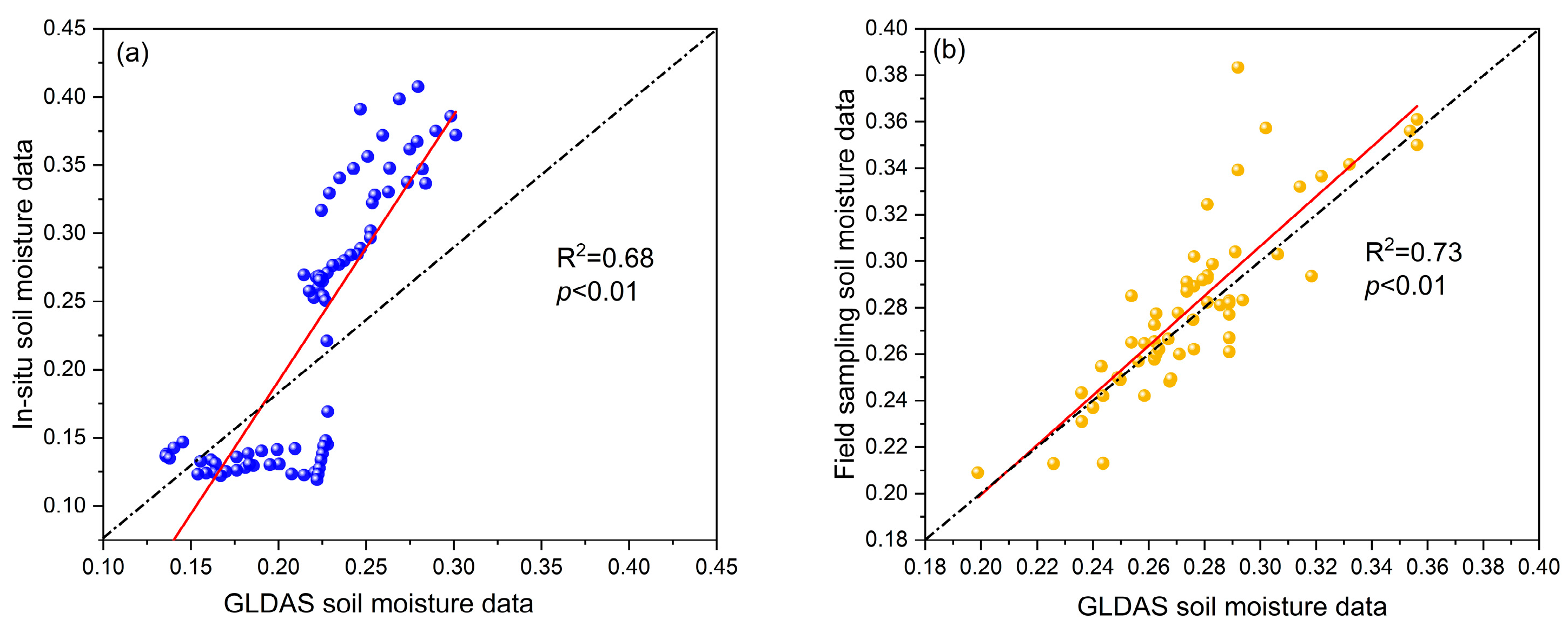
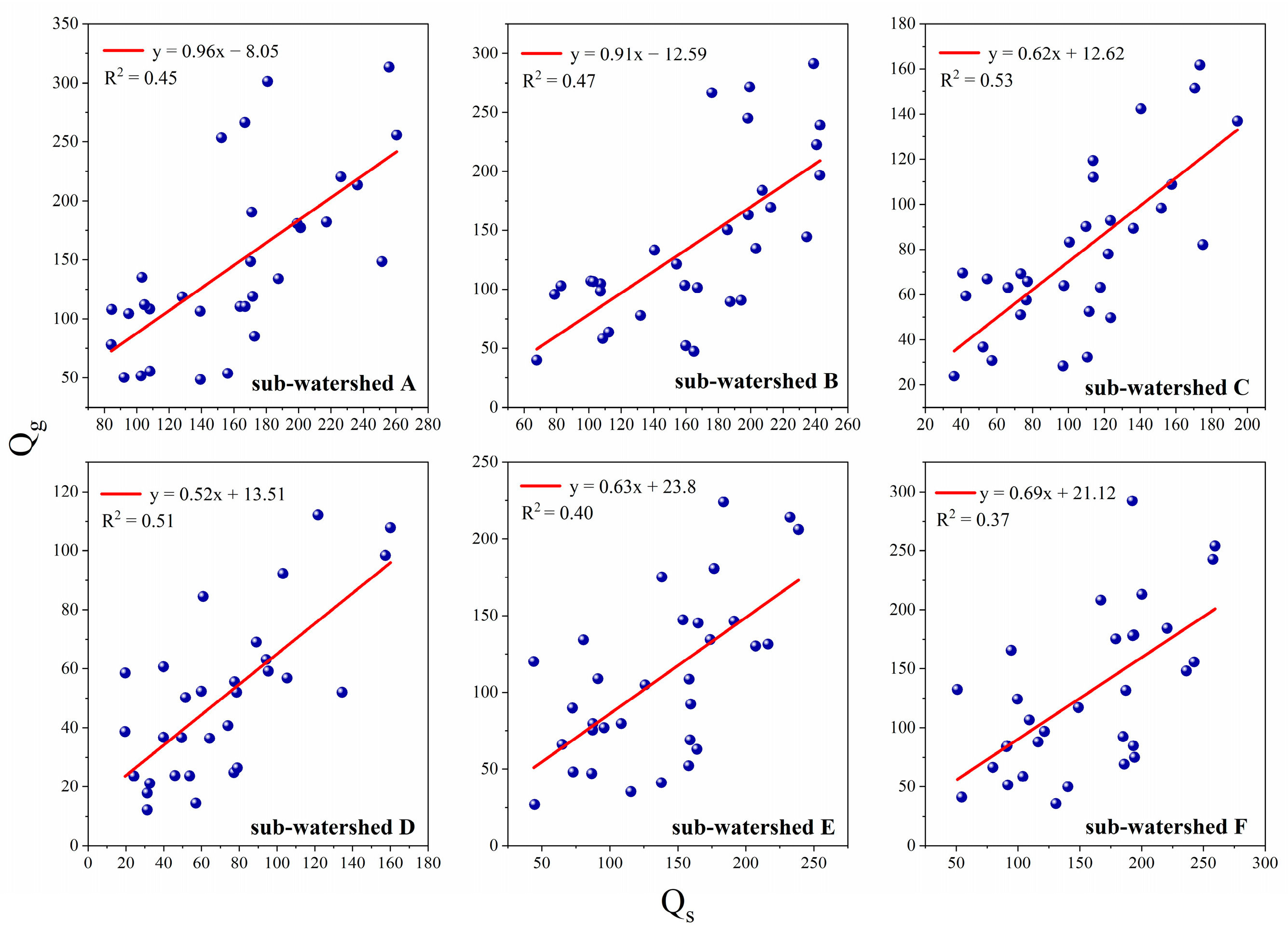
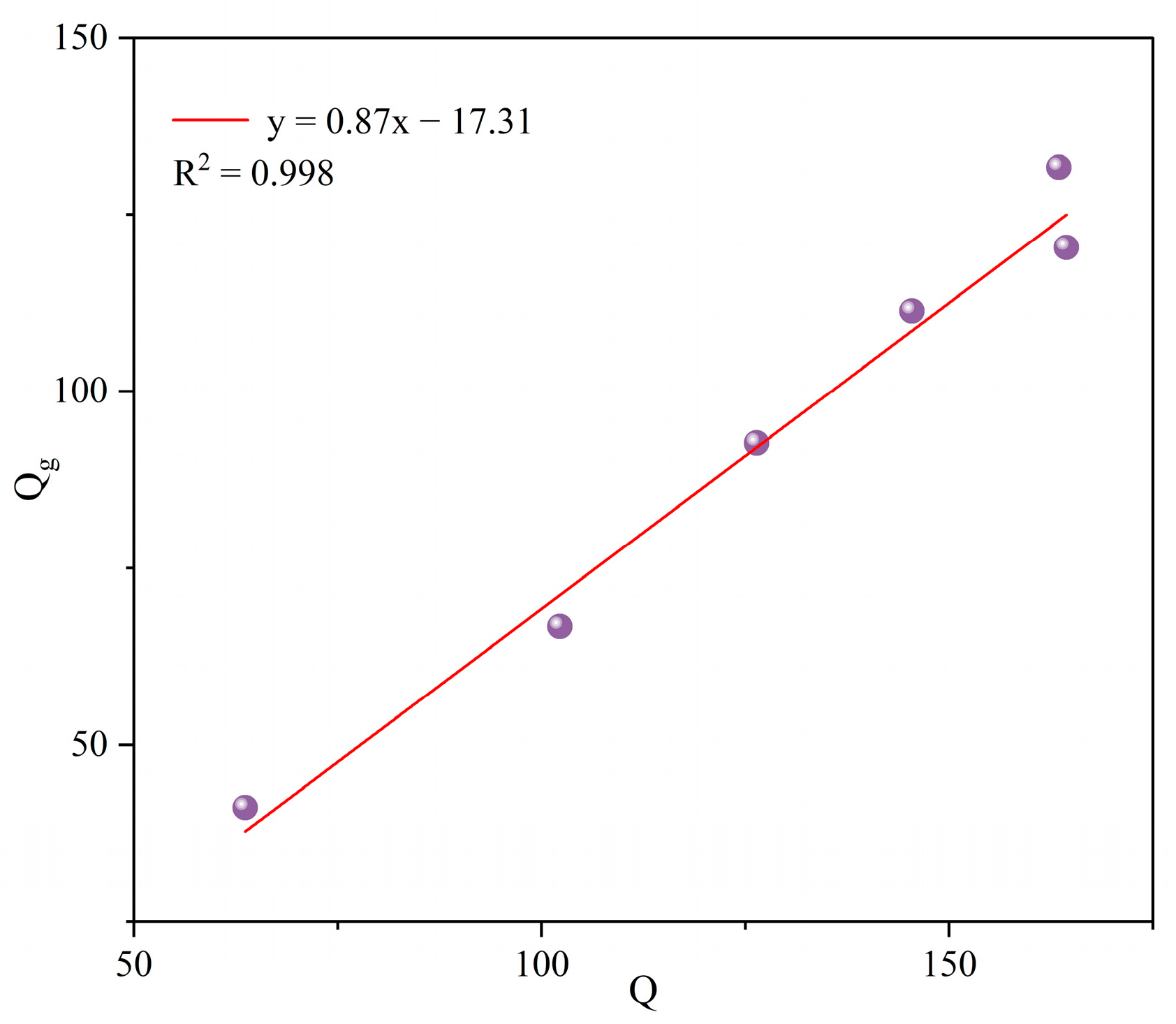

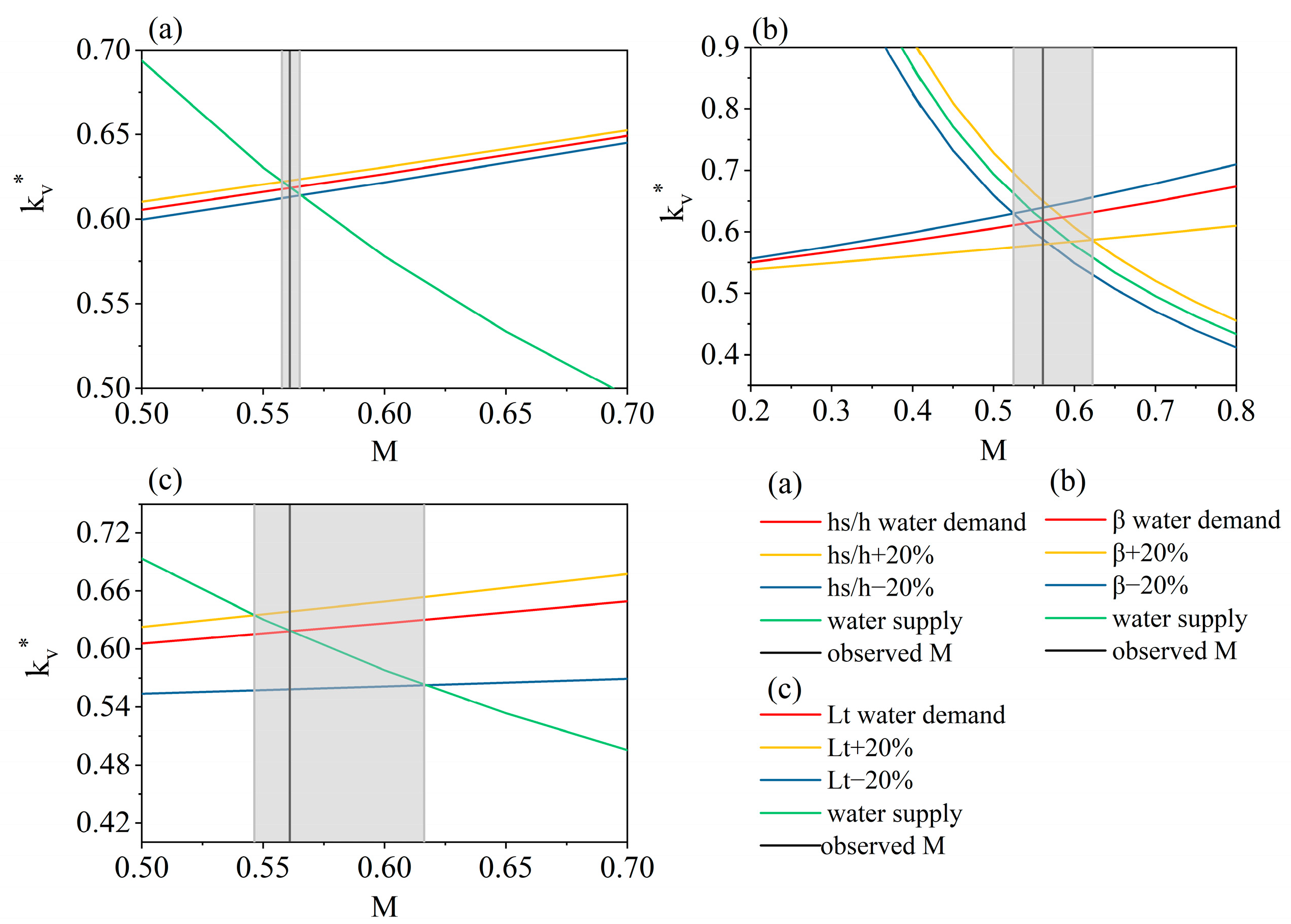

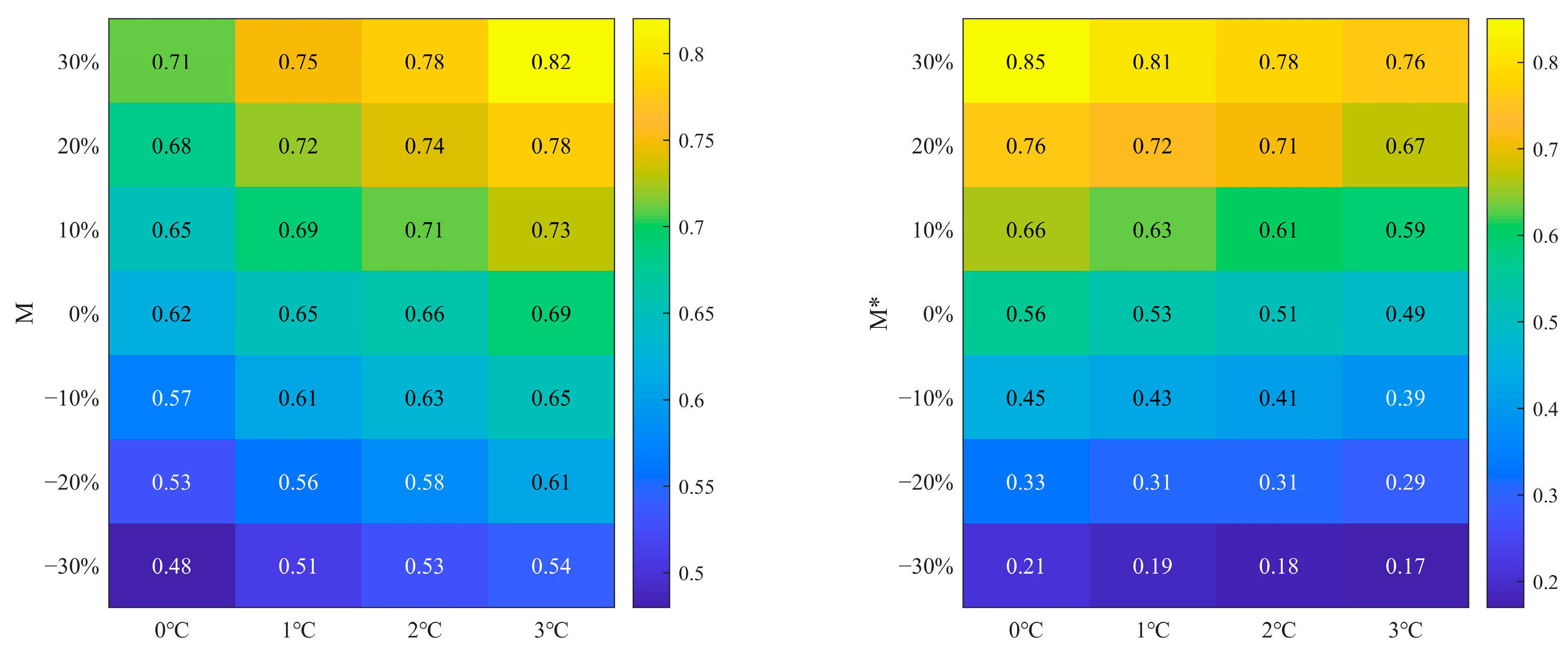
| Main Inputs | Name | Description | Unit |
|---|---|---|---|
| Climate conditions | md | Length of the growing season | day |
| mv | Amount of precipitation | dimensionless | |
| mh | Rainfall event depth | mm | |
| mtb | Mean time between precipitation | day | |
| mtb′ | Mean time spent on transpiration between precipitation | day | |
| mtb″ | Mean time spent on evaporation of bare soil between precipitation | day | |
| Pd | Precipitation in the non-growing season | mm | |
| The ratio between initial and total evapotranspiration | dimensionless | ||
| Soil properties | βv | Canopy transpiration efficiency | dimensionless |
| Epsd | Potential evapotranspiration during the growing season | mm day−1 | |
| Eps | Potential evapotranspiration of moist soil | mm day−1 | |
| βs | Evaporation efficiency of bare soil | dimensionless | |
| Vegetation parameters | M | Average vegetation cover of the growing season | dimensionless |
| Md | Average vegetation coverage of the non-growing season | dimensionless | |
| Potential canopy conduction | dimensionless | ||
| Canopy precipitation interception | mm | ||
| The ratio of the stomal area to the leaf area | dimensionless | ||
| Lt | Leaf area index | dimensionless | |
| β | Cosine of the angle the leaf surface makes with the horizon | dimensionless |
| Vegetation Parameters | M* Change in Value | The Sensitivity of M* to Parameter Changes | ||
|---|---|---|---|---|
| 20% | −20% | 20% | −20% | |
| 0.56 | 0.57 | −0.61% | 0.72% | |
| 0.62 | 0.52 | 10.92% | −6.41% | |
| 0.54 | 0.61 | −2.51% | 9.82% | |
| Meteorological Parameters | M* Change in Value | The Sensitivity of M* to Parameter Changes | ||
|---|---|---|---|---|
| 20% | −20% | 20% | −20% | |
| 0.76 | 0.33 | 35.56% | −41.17% | |
| 0.48 | 0.67 | −14.32% | 20.12% | |
| 0.48 | 0.67 | −14.11% | 20.35% | |
| T | 0.50 | 0.60 | −10.72% | 8.70% |
Disclaimer/Publisher’s Note: The statements, opinions and data contained in all publications are solely those of the individual author(s) and contributor(s) and not of MDPI and/or the editor(s). MDPI and/or the editor(s) disclaim responsibility for any injury to people or property resulting from any ideas, methods, instructions or products referred to in the content. |
© 2024 by the authors. Licensee MDPI, Basel, Switzerland. This article is an open access article distributed under the terms and conditions of the Creative Commons Attribution (CC BY) license (https://creativecommons.org/licenses/by/4.0/).
Share and Cite
Fang, Q.; Yue, Z.; Zhang, S.; Wang, G.; Xue, B.; Guo, Z. Effects of Climatic Disturbance on the Trade-Off between the Vegetation Pattern and Water Balance Based on a Novel Model and Accurately Remotely Sensed Data in a Semiarid Basin. Remote Sens. 2024, 16, 2132. https://doi.org/10.3390/rs16122132
Fang Q, Yue Z, Zhang S, Wang G, Xue B, Guo Z. Effects of Climatic Disturbance on the Trade-Off between the Vegetation Pattern and Water Balance Based on a Novel Model and Accurately Remotely Sensed Data in a Semiarid Basin. Remote Sensing. 2024; 16(12):2132. https://doi.org/10.3390/rs16122132
Chicago/Turabian StyleFang, Qingqing, Ziqi Yue, Shanghong Zhang, Guoqiang Wang, Baolin Xue, and Zixiang Guo. 2024. "Effects of Climatic Disturbance on the Trade-Off between the Vegetation Pattern and Water Balance Based on a Novel Model and Accurately Remotely Sensed Data in a Semiarid Basin" Remote Sensing 16, no. 12: 2132. https://doi.org/10.3390/rs16122132
APA StyleFang, Q., Yue, Z., Zhang, S., Wang, G., Xue, B., & Guo, Z. (2024). Effects of Climatic Disturbance on the Trade-Off between the Vegetation Pattern and Water Balance Based on a Novel Model and Accurately Remotely Sensed Data in a Semiarid Basin. Remote Sensing, 16(12), 2132. https://doi.org/10.3390/rs16122132







